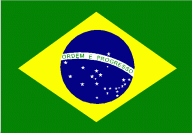Origins and History
Samba is Brazil's most well-known musical form and most widely played kind of Brazilian music. Samba evolved in Rio de Janeiro by the early 20th century and grew to become the quintessential music and dance form associated with Rio's carnaval. With its rich and syncopated rhythm and its often voluptuous dance moves, it has become the most popular music and dance style of South America. Brazilian musicologists argue about the origins of samba. The word samba most likely is derived from the Kimbundu (Angolan) term semba- the belly bump or navel thrust in dancing. According to Silvio Romero (1954), the term was associated with a Bahian (one of the twenty-six states of Brazil) dance in the second half of the 1800's, when Bahian ex-slaves brought it to Rio de Janeiro. Kazadi wa Mukuna (1979) argues that it may have developed on the coffee plantations of the Paraiba Valley before reaching the capital. Jose Ramos Tinhorao (1986) argues that samba was a product of a middle-class elaboration of Afro-Brazilian musical practices by professional musicians in Rio.
Over time samba gained important influences not only from Brazilian predecessors such as the maxixe and the marcha, but the Cuban habanera and German polka as well. As a song form, samba was extremely popular during the turn of the century, with some of the early recordings dating back to 1911. The first officially registered and recorded samba was "Pelo Telefone," which became a hit in 1917. Among the early pioneers of the song form was Alfredo da Rocha Vianna Jr., known as Pixinguinha, who helped to crystallize the form as well as develop a richer harmony. From the 1920s and into the height of the radio era of the '30s, sambas were slower and more romantic (such as those of Ismael Silva), leading to the subgenre known as samba-canção, which emphasized the melody over the rhythm, and lyrics that were more sentimental and often moody. Brazilian crooners and composers put samba on the international radar.
By the 1950s, as samba-canção began to lose its momentum, a more percussive and funkier style of samba began to develop in the poor areas and shantytowns (known as favelas). At first called samba de morro because of its development in the morros (hills), the style came to be known as samba-de-batucada, and emphasized the polyrhythmic sounds of multiple percussion instruments. In the late 1950s, the second international wave of popularity for Brazilian music began: the development of bossa nova. Considered an adaptation of the previous samba- canção form, bossa nova emphasized the melodic and vocal aspects of samba in a slower, more romantic style fused with the richness of American jazz harmony. By the 1970s, samba saw its rise within the era of MPB (música popular Brasileira) as artists modernized the more dynamic batucada style with contemporary harmony and instrumentation, fusing samba with rock, jazz and other forms, and bringing the style into the mainstream. Samba was everywhere, and it seemed to be the measure of happiness for Brazilians of all races and social classes.

